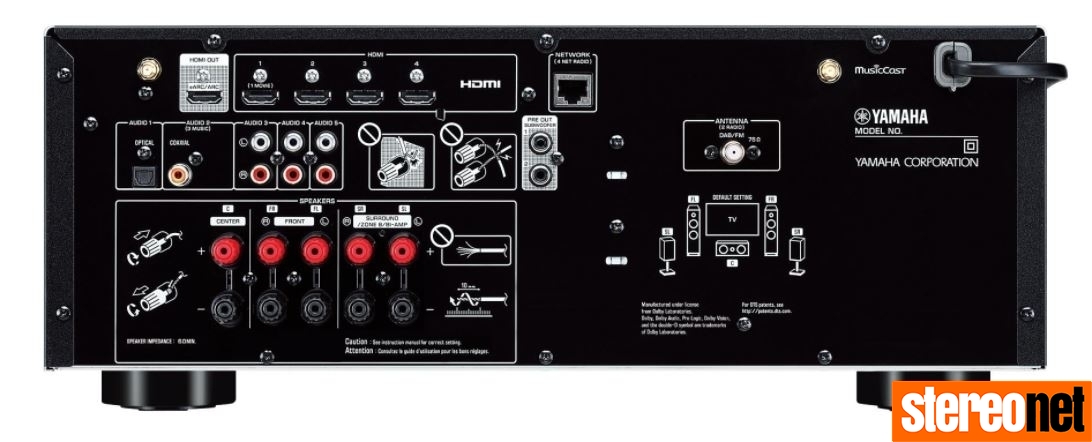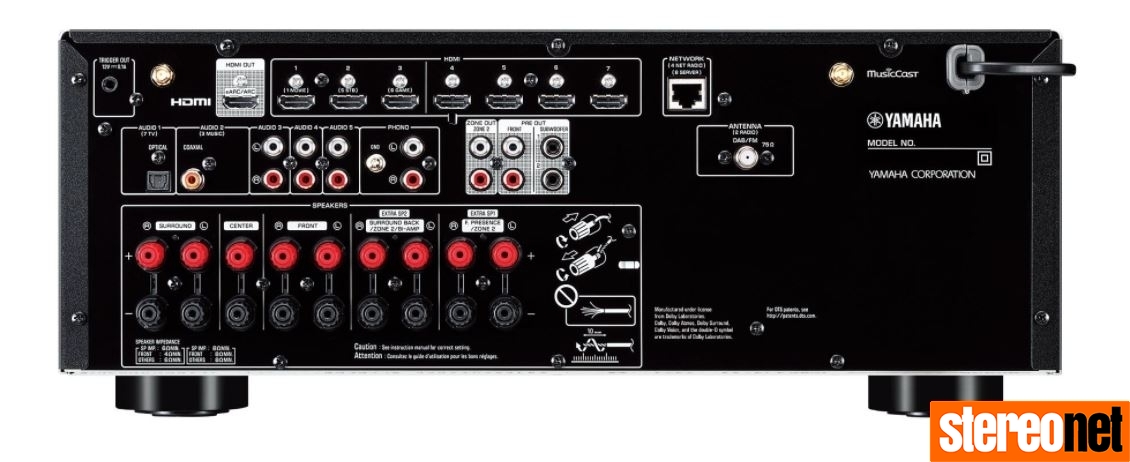Yamaha Announces Massively Redesigned AV Receivers

Come September you'll be able to see what Yamaha thinks home theatre receivers should look like into the future. Read on as we reveal more about Yamaha's two new RX-V AV Receivers.
Most home theatre receivers from most brands have been sharp-cornered black boxes with central blue-green dot-matrix displays and their volume knobs to the right. Highly practical, but far from pretty. It has been thus for more than two decades.

But the two new models from Yamaha's RX-V range are changing all that, with a curved front, a bold volume control right at the centre and an off-set LCD display – albeit still in blue-green.
Yamaha RX-V4A
The two new receivers are closer to the entry-level end of Yamaha's range. The £449 RX-V4A – yes, the model number scheme has also changed – is a 5.1 channel model rated at 80 watts per channel (6 ohms, 0.06% THD, 20Hz-20kHz, 2 channels driven). It features four HDMI inputs, all rated at up to 8K at 60 hertz and 4K at 120 hertz. The HDMI output supports eARC.

A network receiver, the RX-V4A has an Ethernet connection plus dual-band Wi-Fi and of course, works with Yamaha's MusicCast multi-room system. It offers high-resolution network audio support up to 192kHz sampling (and 11.2MHz DSD).

Yamaha RX-V6A
The RX-V6A is quite a step up. Priced at £649 it is a 7.2 channel unit with a rated output of 100 watts per channel (8 ohms for this one, 0.06% THD, 20Hz-20kHz, 2 channels driven). It gets seven HDMI inputs, an extra line-level analogue input plus a phono input. In addition to the usual pair of subwoofer outputs, it also has line outputs for the front stereo speakers, thus allowing the use of separate power amplifiers for stereo music.
In line with that greater focus on higher-end sound, it ups the network audio handling to 24-bit, 384kHz for PCM-based formats (only 96kHz for Apple Lossless). DSD handling remains at 11.2MHz.

Both models feature 17 DSP modes, and a (best avoided) Compressed Music Enhancer. More importantly, they both have a Direct mode which minimises sound processing.
The RX-V4A, being a 5.1 channel unit, does not support Dolby Atmos or DTS:X, while the RX-V6A does.

Yoshi Tsugawa, Senior General Manager at Yamaha's Home Audio Division in Japan, told StereoNET:
We've modernised the AV receiver to fit your emerging needs – from the rising size and resolution of TV screens to the speed and life-like realism of the latest gaming consoles and platforms. We're here to ensure that your gear is ready for these latest innovations, complementing the stunning visuals on your screen with thrilling sound all around you,
Both models will be available in September 2020.
For more information, please visit Yamaha.
Marc Rushton
StereoNET’s Founder and Publisher was born in England and raised on British Hi-Fi before moving to Australia. He developed an early love of music and playing bass guitar before discovering the studio and the other side of the mixing desk. After writing for print magazines, Marc saw the future in digital publishing and founded the first version of StereoNET in 1999.
Posted in: Home Theatre
JOIN IN THE DISCUSSION
Want to share your opinion or get advice from other enthusiasts? Then head into the Message
Forums where thousands of other enthusiasts are communicating on a daily basis.
CLICK HERE FOR FREE MEMBERSHIP
Trending
applause awards
Each time StereoNET reviews a product, it is considered for an Applause Award. Winning one marks it out as a design of great quality and distinction – a special product in its class, on the grounds of either performance, value for money, or usually both.
Applause Awards are personally issued by StereoNET’s global Editor-in-Chief, David Price – who has over three decades of experience reviewing hi-fi products at the highest level – after consulting with our senior editorial team. They are not automatically given with all reviews, nor can manufacturers purchase them.
The StereoNET editorial team includes some of the world’s most experienced and respected hi-fi journalists with a vast wealth of knowledge. Some have edited popular English language hi-fi magazines, and others have been senior contributors to famous audio journals stretching back to the late 1970s. And we also employ professional IT and home theatre specialists who work at the cutting edge of today’s technology.
We believe that no other online hi-fi and home cinema resource offers such expert knowledge, so when StereoNET gives an Applause Award, it is a trustworthy hallmark of quality. Receiving such an award is the prerequisite to becoming eligible for our annual Product of the Year awards, awarded only to the finest designs in their respective categories. Buyers of hi-fi, home cinema, and headphones can be sure that a StereoNET Applause Award winner is worthy of your most serious attention.










